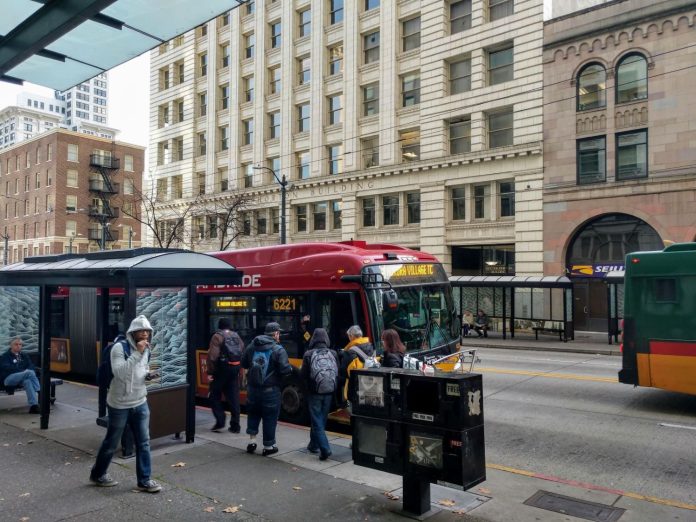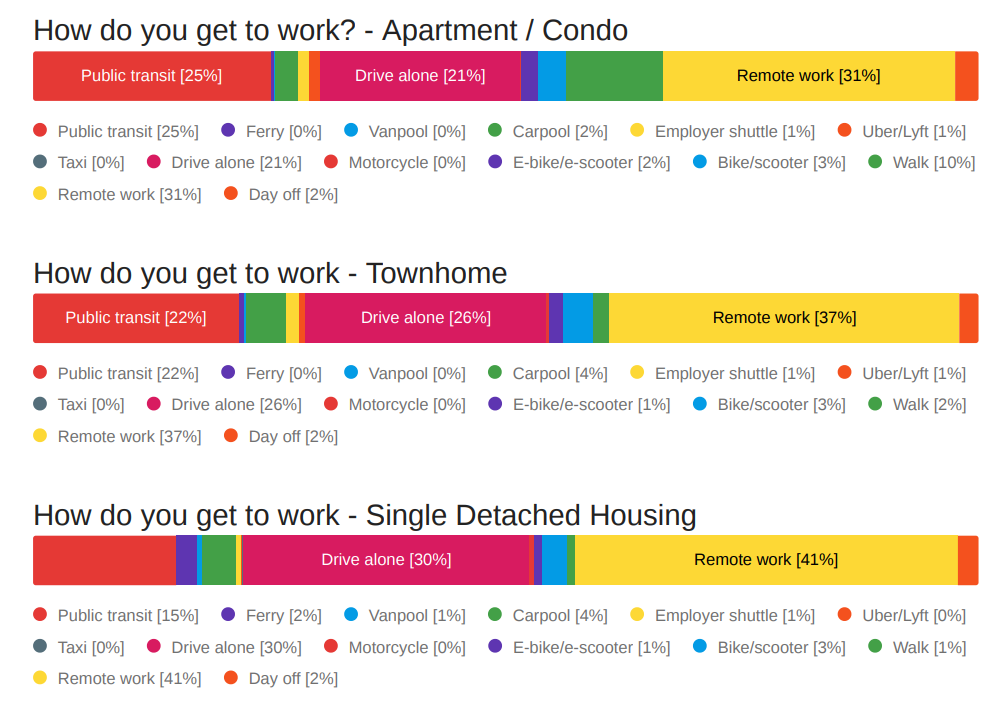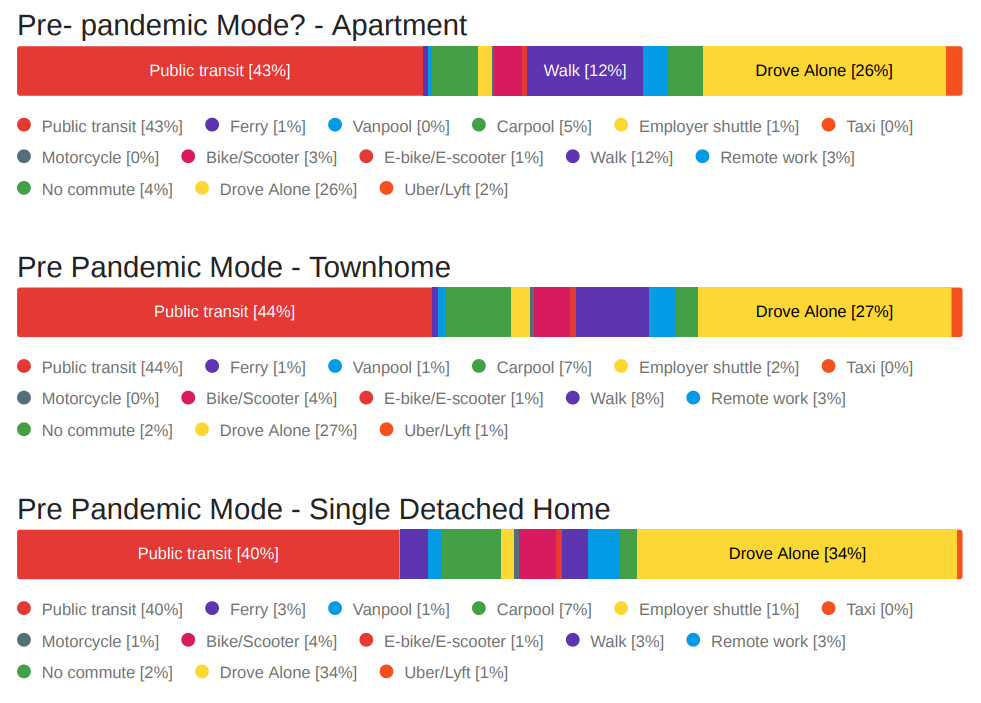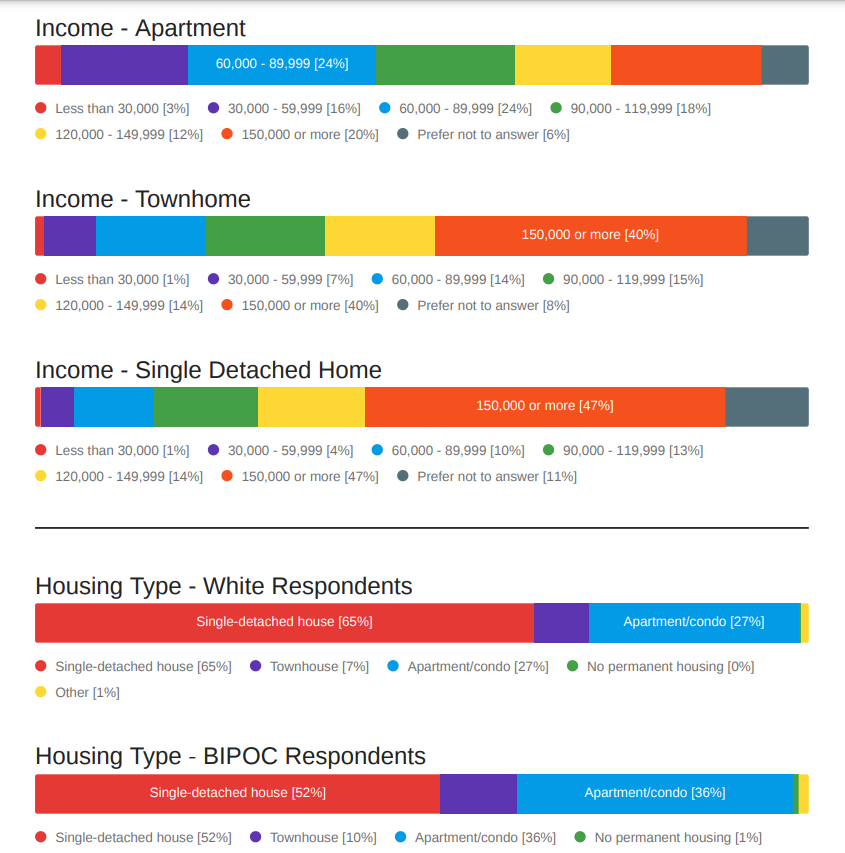
Denser housing would help too, as survey finds apartment dwellers more likely to ride transit or walk.
Commute Seattle’s annual survey is a unique snapshot into how people are getting around the city. One big takeaway of this year’s report is transit ridership is rebounding slowly from pandemic lows, with commuters citing the slowness, unreliability, and inconvenience of transit as the main obstacles to riding. Another takeaway: the most congested days are now midweek as many white collar workers continue to telework on Monday and Friday, but come into the office midweek.
The survey underscored that what type of housing people live in has a big impact on their transportation choices. Apartment dwellers are much more likely to ride transit or walk versus drive alone to work. People in detached single family homes are the most likely to drive, with townhome dwellers not far behind.
Differences in walking rates and telework rates are striking. Ten percent of people who live in apartments walk to work, but just 1% of people who live in single detached housing and 2% of townhome residents. Telework has become very common among single family home residents at 41%, but less so for apartment dwellers at 31%.
With 64,000 survey responses, the survey is a treasure trove of information about how transportation choices connect to a number of other factors included in the questions. Washington State’s commute trip reduction law helped ensure this large sample since it requires employers with at least 100 employees arriving between 6am to 9am respond to the survey with a rate of at least 50%.
Kirk Hovenkotter, executive director at Commute Seattle, said this correlation suggests policy implications and the need for further analysis of the dataset.
“If we want to get people walking, biking, and taking transit and we want our neighborhood centers and our downtown to be vibrant, we need more walkable workforce housing,” Hovenkotter said. “We need more housing in our neighborhoods with great sidewalks and near our great transit service that we are investing in.”
Before the pandemic, transit use was relatively high across the board for folks heading into Seattle’s downtown core. All three segments — apartment/condo, townhomes, and detached single-family homes — all were at 40% or greater for using transit to get to work.
“At the end of day, what motivates people to get around by transit is having it get them from point A to point B as quickly as possible.”
Kirk Hovenkotter, executive director at Commute Seattle
In the pandemic era, transit use is down across the board, but especially for detached housing dwellers, at just 15% — though ferry, vanpool, and employee shuttle do carry another 4%. Meanwhile a quarter of people living in apartments and condo and 22% of townhome residents are still riding transit to work, according to the survey. This is borne out in King County Metro ridership data, too, as systemwide transit ridership hovers around about half of what it was pre-pandemic, which is partial rebound from the lowest lows of the pandemic.
Survey respondents cited time, convenience, and cost as the three main motivators in their transportation choices. This suggests a strong desire for transit that is faster, more reliable, more affordable, and more convenient. Hovenkotter and Commute Seattle’s new policy and communications director Noah An, who came over after serving as an aide under Councilmember Dan Strauss and Councilmember Rob Johnson before that, stressed this point.
“People are overwhelmingly focused on cost, convenience, and time. That’s what they care about; it’s reliable, frequent, affordable, reliable transit, An said. “And while safety is an important part of the conversation, it’s not really the primary factor that’s driving people’s decision making.”
While 27% of people who drive alone to work cited safety concerns as a reason for that choice, twice as many respondents cited time and convenience. Childcare obligations was the third most cited reason for driving alone to work, also ahead of safety concerns. Nonetheless, safety has dominated conversations about attracting people back onto transit — and back into downtown, for that matter.
“It’s not just building more of the housing, it’s providing the really frequent, fast, reliable transit service,” Hovenkotter said. “At the end of day, what motivates people to get around by transit is having it get them from point A to point B as quickly as possible.”
People who live in an apartment or condo said they live on average seven minutes from a transit stop. Single detached homes average 11 minutes from a transit stop. It appears that extra four minutes makes a world of difference, especially considering transit frequencies tend to be lower in lower-density single family areas, meaning longer waits at the bus stop.
The survey indicates childcare obligations are pushing people to drive and toward single detached housing, but more family-sized housing in walkable, transit-rich areas could counteract that.
“Not only do we need more housing in walkable areas, but we need housing that has two to three bedrooms,” Hovenkotter said. “If we have so many of the parents thinking that need to live in single detached homes in order to offer the quality of life they want for their kids, we’re not going to build in a society or a community were we can walk and bike and take transit and make that a first choice for people.”
Income and race differences are also pronounced between single family homeowners and apartment and condo residents. The survey found 47% of single family households make at least $150,000 versus only 20% in the multifamily segment. Meanwhile, 65% of White respondents live in single detached housing versus 52% of Black, Indigenous, and people of color (BIPOC) respondents.
Not much about pandemic recovery has been easy, let alone equitable. Nonetheless, investing in speeding up transit, boosting frequencies, increasing walkability, and adding dense family-sized housing near it all seems like a great recipe to make it easier to get around Seattle, reduce climate pollution, and lower living costs for families.
The Commute Seattle survey is a great window into how Seattleites are choosing to get around. Policymakers would be wise to dig into the data and heed the lessons learned.
Doug Trumm is publisher of The Urbanist. An Urbanist writer since 2015, he dreams of pedestrian streets, bus lanes, and a mass-timber building spree to end our housing crisis. He graduated from the Evans School of Public Policy and Governance at the University of Washington in 2019. He lives in Seattle's Fremont neighborhood and loves to explore the city by foot and by bike.




